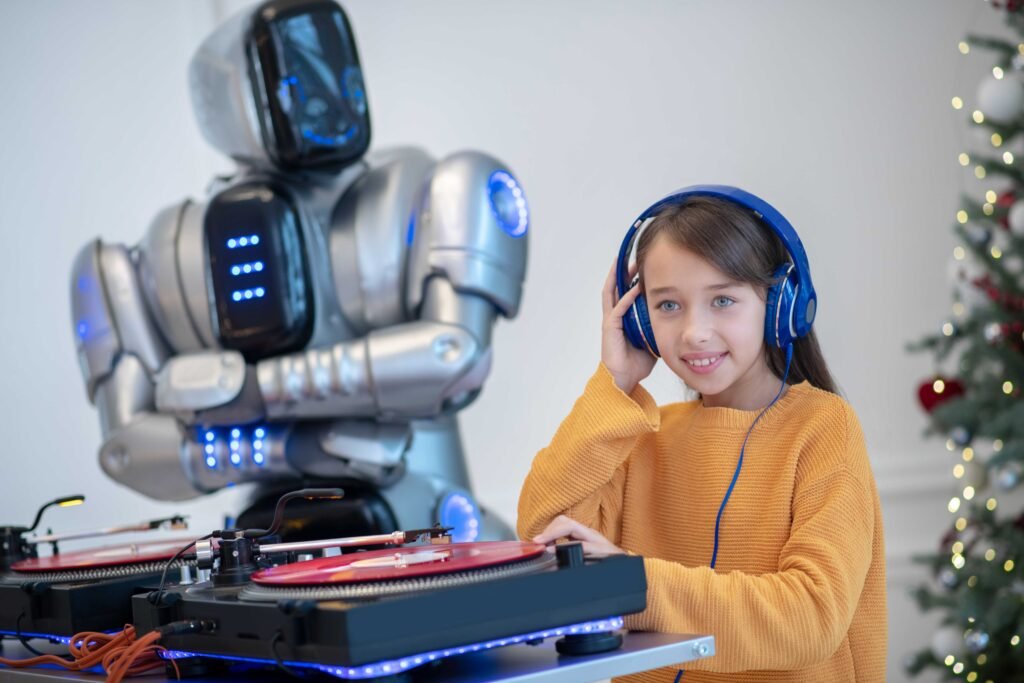In the dynamic world of technology and education, Kid Voices AI stands out as a promising innovation reshaping how families and educators approach learning. Designed for youngsters, this sophisticated artificial intelligence technology provides dynamic and interesting experiences that improve conventional learning approaches. Understanding the potential of Kid Voices AI will create new paths for parents, teachers, and tech buffs to improve the lives and education of their children. We will analyze the critical role Kid Voices AI plays in revolutionizing family tech and learning, go over its advantages, look at actual uses, and debate relevant ethical issues during this article.
The Role of Kid Voices AI for Parents
Enhancing Learning Experiences at Home
Making an efficient and fun classroom at home top concern for many parents is also Through interactive learning tools that fit children’s particular learning methods and preferences, Kid Voices AI supports this effort. Parents may turn routine chores into teaching and growth-oriented opportunities by including Kid Voices AI into daily events.
Imagine a virtual assistant that motivates inquiry and discovery in addition to helping with schoolwork. Children may participate in tailored learning experiences that fit their interests and level of development by means of Kid Voices AI, thereby naturally incorporating education into their everyday lives. This tailored method improves information retention as well as a passion of learning.
Managing Screen Time and Fostering Creativity
Many parents in the digital era of today worry much about screen time management. Kid Voices AI presents a solution by turning passive screen time into a participatory and creative experience. Children may acquire important skills and appropriately enjoy their screen time by means of narrative applications and instructional games.
For example, consider a mobile app that uses Kid Voices AI to narrate stories while encouraging children to create their own endings. This interactive storytelling not only boosts reading comprehension but also inspires creativity and imagination. By fostering creativity through AI-driven tools, parents can ensure that screen time becomes a productive and enriching experience.
Incorporating Keywords Naturally
By integrating Kid Voices AI into family tech, parents can create an environment where learning AI is seamlessly woven into daily activities. This integration allows children to explore technology in a safe and educational manner, preparing them for future challenges and opportunities.
Understanding AI for Kids
A Child-Friendly Tech Revolution
AI technology tailored for children is revolutionizing how young users interact with technology. These digital assistants are designed to engage children with friendly, accessible voices that can relay information, entertain, and educate. Unlike traditional AI interfaces, kid-friendly versions focus on simplicity and safety, ensuring that children access content that is appropriate and beneficial to their development.
Benefits of Kid-Centric AI
Kids benefit greatly from AI designed specifically for them.It fosters not just curiosity and learning but also entertaining and interesting methods of developing critical thinking ability. Knowing these gadgets are made to meet a child’s cognitive demands while preserving rigorous security measures helps parents relax.
Impact on Family Dynamics
By integrating AI into daily routines, families can enhance their communication and bonding. Digital assistants can act as mediators for family activities, helping organize schedules, remind about important tasks, or even suggest family games and stories. This creates a balanced tech environment that aligns with family values.
Impact on Education
Integrating Kid Voices AI in Formal Education Settings
Kid Voices AI is not only a tool for personal usage but also a tool for formal education environments, therefore transforming conventional teaching strategies. AI technology is being used by schools and teachers more and more to improve classroom environments and meet different learning requirements.
For language development, Kid Voices AI has shown to be a useful tool in preschool environments among other settings. Using Kid Voices AI as part of the curriculum resulted in notable increases in children’s language abilities and engagement levels, according a research done in a preschool setting. Kid Voices AI guides young students in developing vital communication skills by providing interactive language drills and tailored feedback.
Case Studies in Preschool, Storytelling Apps, and Educational Gaming
Let’s take a closer look at some real-world examples of Kid Voices AI in action. In addition to the preschool study mentioned earlier, an analysis of a mobile application utilizing Kid Voices AI for storytelling revealed enhanced reading comprehension and creativity among young users. By allowing children to choose their story paths and interact with characters, the app transformed passive reading into an immersive experience.
Furthermore, educational gaming platforms that integrate Kid Voices AI have demonstrated remarkable improvements in problem-solving skills and critical thinking among elementary school children. By challenging kids to solve puzzles and complete missions, these platforms promote cognitive development while keeping learning fun.
Expert Insight on Cognitive Development
According to Prof. Emily Chen, an AI in Education Researcher, “The integration of AI in education, especially at an early age, can significantly enhance cognitive development and critical thinking skills.” This expert perspective underscores the transformative potential of Kid Voices AI in shaping future generations of learners.
Challenges and Ethical Considerations
Addressing Concerns and Potential Drawbacks
Although Kid Voices AI clearly offers advantages, it is important to handle certain difficulties and ethical issues related to its application. The over-reliance on technology raises serious issues as it can reduce chances for outdoor activities and impede social contacts. Parents and teachers have to find a balance between using artificial intelligence technologies and encouraging actual experiences.
The possibility of bias in artificial intelligence systems presents even another difficulty. Kid Voices AI must be made to be inclusive and fairly reflecting of many points of view. Through proactive addressing of these prejudices, developers may provide a more fair and rewarding experience for every youngster.
Ensuring Ethical Design and Use
Kid Voices AI must be designed and used with ethical issues first in mind if it is to fully realize its promise. Emphasizing the requirement of ethical design, Child Development Specialist Dr. Alex Johnson says, “Kid Voices AI technologies have the potential to create personalized learning experiences, catering each child’s unique needs and interests.” Giving ethical design a priority helps engineers make sure youngsters gain from artificial intelligence without endangering their welfare.
Privacy and Security Concerns
Child privacy advocate Sarah Patel also emphasizes the need of privacy and security in the context of artificial intelligence applied in children’s technologies. “We must be aware of the ethical issues and privacy concerns that accompany the use of artificial intelligence in children’s technology, so guaranteeing that their welfare always comes first.” Protecting children’s privacy and fostering confidence with parents and teachers depend on strong security policies and open data practices being followed.
The Future of Kid Voices AI
Predictions and Emerging Trends
Kid Voices AI is positioned for even more developments and inventions as technology keeps changing. The opportunities are unlimited from AI-powered tutors offering real-time help to cooperative learning systems linking students all over. These new developments could change the scene of schooling and modify our attitude to family technology.
Potential Innovations and Improvements
AI technology should get increasingly more complex and understandable in the next years. Developers will probably concentrate on building flawless and user-friendly interfaces that let kids and artificial intelligence technologies communicate easily. Kid Voices AI is also a great friend for students of all ages as developments in natural language processing and machine learning will improve its capacities even more.
Closing Thoughts on the Transformative Power of AI
Emphasizing the potential of Kid Voices AI, Tech Ethicist Dr. Michael Lee says, “When designed and used ethically, Kid Voices AI can be a powerful tool to foster creativity and innovation in children, prepared for the digital future.” We can enable kids to flourish in a world going more and more digital by using artificial intelligence’s transforming ability.
Conclusion
By providing individualized and interesting learning opportunities for children, Kid Voices AI is transforming family tech and learning. From improving learning at home to changing official education environments, this sophisticated technology is changing our approach to child development and education. Although ethical issues and difficulties abound, Kid Voices AI’s possible advantages much exceed its disadvantages.
Parents, teachers, and techies may open fresh chances for creativity, cognitive growth, and critical thinking by including Kid Voices AI into family tech and learning settings. It is imperative to give ethical design top priority and guarantee that children’s welfare stays first while we investigate the potential of artificial intelligence technologies.
As we together strive to fully use this creative technology, we urge readers to contribute their experiences and thoughts on Kid Voices AI. Kid Voices AI is a great road forward for changing family tech and learning for the better regardless of your level of parent, teacher, or tech enthusiast.
Frequently Asked Questions (FAQ)
What is Kid Voices AI?
Kid Voices AI is a sophisticated technology including artificial intelligence into children’s learning environments. By offering interactive learning opportunities catered to every child’s particular needs and interests, it stimulates cognitive growth.
How does Kid Voices AI enhance cognitive development?
By challenging children with puzzles and missions, Kid Voices AI stimulates problem-solving skills and critical thinking. This approach keeps learning engaging while supporting cognitive growth in elementary school children.
What are the ethical considerations in using Kid Voices AI?
Ethical considerations include ensuring unbiased AI algorithms and protecting children’s privacy. Developers must prioritize equitable design to offer inclusive experiences and robust security measures to safeguard children’s information.
Are there potential drawbacks to using Kid Voices AI?
Potential drawbacks include the risk of over-reliance on technology, which may impact social interactions and offline activities. Balancing AI use with real-world experiences is important to ensure holistic development.
How can Kid Voices AI shape the future of education?
As technology advances, Kid Voices AI can revolutionize education with AI-powered tutors and collaborative learning platforms. These innovations can transform educational approaches and redefine family tech.
Is Kid Voices AI safe for children to use?
Though Kid Voices AI is built with children’s safety in mind, it is imperative to apply open data policies and security protocols. Teachers and parents are urged to keep educated and alert to guarantee the welfare of their children.
What will future advancements in Kid Voices AI look like?
Future advancements may involve more intuitive interfaces and enhanced natural language processing. These improvements aim to create more seamless interactions and expand the capabilities of Kid Voices AI for learners.


